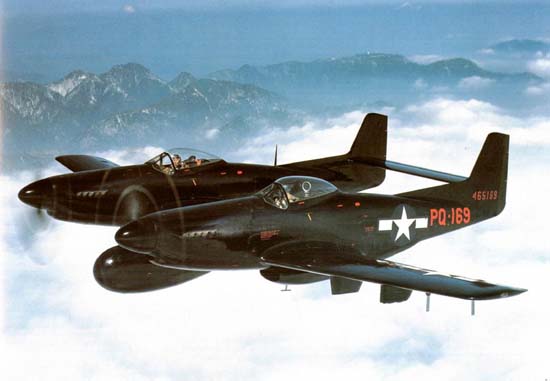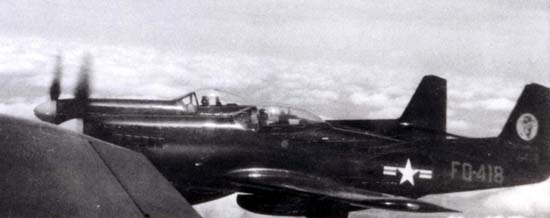|
|
|
THE P-82 ERA (1948 - 1950) |
|
|
 |
|
USAF |
|
The last propeller driven
fighter aircraft purchased in large quantity by the U.S. Air Force, the
North American F-82 Twin Mustang only had a 20%
commonality in parts with its cousin, the
P-51 Mustang.
|
|
|
|
Before transferring to
McChord, the 318th began a transition from the Northrop P-61 Black Widow
into the North American F-82F Twin Mustang in October of 1948. The
F-82F Twin Mustang, the F-82 was the last
propeller-driven fighter acquired in quantity by the USAF, had a
basic design that consisted of a two
lengthened P-51H fuselages mounted to a newly designed
center wing, tail, and propellers, as well as having a unique four-wheel
landing gear.
|
|
|
|
Even though
the P-51 was used as the base for the design of the P-82, the two
aircraft only have a 20% commonality in parts. The extra
fuel needed for the long-range missions lead to increasing the length of
the fuselage, which led to a higher weight and the need to install a
more powerful engine, stronger wings, and larger control surfaces. While
the early versions of the F-82's retained both fully equipped cockpits
where the aircraft could be flown from either position, the later night
fighter versions kept the cockpit on the left side only, placing the
radar operator in the right position.
|
|
|
 |
|
PHOTO FROM
"F-82 TWIN MUSTANG" BY LARRY DAVIS |
|
Flying over Salt Lake City,
UT, the 318th Fighter (All Weather) Squadron's "Green Dragon" insignia
can be seen on the tail of F-82F s/n 46-418 in this 1950 photo.
|
|
|
|
Developed in 1945 as a
long-range escort, the P-82 completed its flight
on 26 June 1945, with the interceptor model P-82F (later redesignated as
the F-82) making its first flight 11 March 1948.
The P-82F carried an AN/APG-28 radar system mounted in a
pod between the two fuselages that was controlled by a
radar operator sitting in the right cockpit. The F-82F was armed with
six 0.50-inch machine guns mounted in the center wing just above the
radar pod.
|
|
|
|
The F-82G was intended
to be more modern aircraft to fill in until more capable jet fighter
aircraft could be developed and with the emergence of the Northrop F-89
Scorpion, and the Lockheed F-94s Starfire, the Twin Mustangs made a
quick exit from service.
|
|
|
|
Next page: The F-94 Era (1950 - 1954) |
|
|
|
|
 |